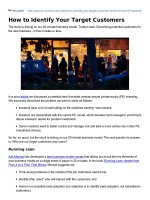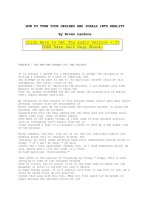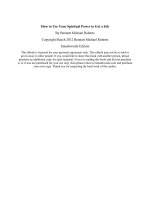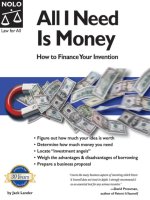How to identify your target customers
Bạn đang xem bản rút gọn của tài liệu. Xem và tải ngay bản đầy đủ của tài liệu tại đây (110.03 KB, 3 trang )
inc.com />How to Identify Your Target Customers
The clock is ticking on our 20-minute business model. Today's task: Describing potential customers for
the new business - in five minutes or less.
In a prior article we discussed a potential new Avondale venture around private equity (PE) investing.
We succinctly described the problem we want to solve as follows:
Investors have a lot of cash sitting on the sidelines earning ~zero returns.
Investors are dissatisfied with the current PE model, which elevates fund managers' enrichment
above investors' desire for prudent investment.
Some investors want to better control and manage risk and take a more active role in their PE
investment choices.
So far, so good, but the clock is ticking on our 20-minute business model. The next question to answer
is: Who are our target customers and users?
Running Lean
Ash Maurya has developed a lean business model canvas that allows you to put the key elements of
your business model on a single sheet of paper in 20 minutes. In his book Running Lean: Iterate from
Plan A to a Plan That Works, Maurya suggests we:
Think about problems in the context of the job customers need done;
Identify other users* who will interact with the customers; and
Home in on possible early adopters (our objective is to identify early adopters, not mainstream
customers).
*From Running Lean: "A customer is someone who pays for your product. A user does not."
Lean Business Model Example: Customer Segments
In this business model, the investor is clearly a customer. Having worked and talked extensively with
individual investors as well as the professional services providers who work with them, we already had
a very clear idea who the early adopter investors would be.
Of course, for every investor there must be an investee, i.e., a business owner who is willing to sell
some or all of their business to Avondale and our investors. Those people are our customers too! They
must see the value in our offer, since their payout is often linked to our ability to create value once we
acquire their company.
Our hypothesis is that there is a large and growing market of retiring or near-retiring business owners,
typically 55-70 years old, who face both a leadership challenge and a capital challenge.
Leadership Challenge
The owner must turn over the business to the next generation of leaders, who may not yet be ready to
hold the reins. In many cases, the owner may not have an individual within their company who can
successfully become the new CEO.
Capital Challenge
The owner may naturally be conserving cash in preparation for retirement, rather than investing to grow
the business. As a result the business may need an infusion of capital to accelerate growth (e.g.,
modernize the facilities, add more production capability, etc.). The retiring owner is financially unable to
make such an infusion, even though they recognize the value potential they are leaving on the table.
With our experience and our network of business leaders and investors, Avondale can help address
both of these challenges. Thus retiring business owners can be a very attractive segment to us.
Our customer segments are therefore:
Customer Segment A
Investors with large chunks of investable cash who have not seen satisfactory results from the current
PE paradigm.
Early adopters: Active entrepreneurs/investors with significant investable cash, who already have a
value creation thesis to pursue.
Customer Segment B
Businesses with attractive growth opportunities that are constrained by capital and/or human resource
limitations and recognize the need for transformation.
Early adopters: Retiring business owners who need to facilitate both a capital and a management
transition.
Because we have been refining and debating these customer segments for a few months now, it was
easy to articulate these segments; it took only three minutes. Nevertheless, with eight minutes of our
20-minute budget already gone, we need to pick up the pace. In the next article in this series we will
discuss our Unique Value Proposition.
Are these attractive customer segments to pursue? Do the problem statement and customer
segments seem well-aligned? Please let us know your thoughts at
Karl Stark and Bill Stewart are managing directors and co-founders of Avondale, a
strategic advisory firm focused on growing companies. Avondale, based in Chicago, is a
high-growth company itself, and is a two-time Inc. 500 award recipient. @karlstark
do.bruce92









